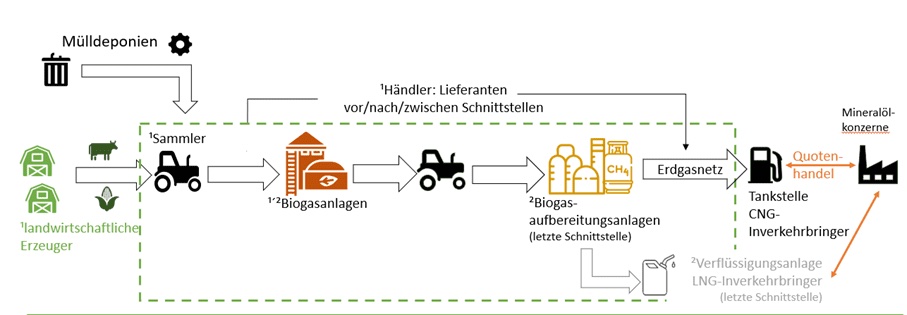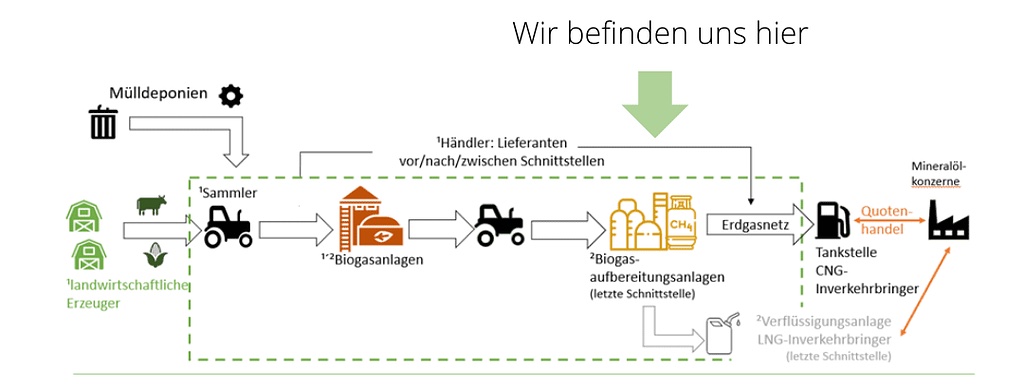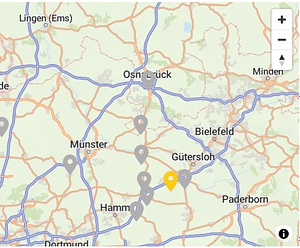Introduction to the value chain of biomethane production
Biomethane as an alternative to e-mobility
How about getting from A to B in a relaxed way without harming the climate? The first thought suggests getting an e-car. However, rare earths such as dysprosium or neodymium are needed to manufacture the batteries. Other elements such as lithium or cobalt must also be used to produce the batteries. As a rule, these elements are in short supply and also have problematic suppliers, such as China for rare earths or the Congo for cobalt. (Dicks, 2020)
So what now?
Is there an alternative that is both environmentally friendly and saves time when refueling?
The answer is a resounding YES! The fuel is called biomethane. What exactly biomethane is, how it is produced and which steps are necessary to get to the final product is explained in this article.
Dicks, H. (Dec. 9, 2020). Biomethane - attractive fuel for the mobility transition.
Step no.1 : Biomethane cultivation/production farm
Origin of the biomethane
This raises the question: How do we turn manure and renewable raw materials into environmentally friendly fuel?
First of all, residues, NaWaRo's, slurry/manure and waste materials from agricultural originating farms and producing farms are collected by collectors, these are mostly traders or suppliers and then transported to the biogas plant. This step is shown in Figure 1.

Figure 1: 1st step in the value chain (agriportance GmbH, 2022)
Processes in the biogas plant
Fermentation of these substances takes place in this plant. During methane formation, microorganisms decompose organic matter in an oxygen-free (anaerobic) environment, releasing biogas. This is a water vapor-saturated gas mixture consisting mainly of methane (CH4) and carbon dioxide (CO2). Other components besides water vapor are trace gases such as nitrogen, oxygen, hydrogen, hydrogen sulfide and ammonia, among others. In biogas and sewage gas plants, these anaerobic fermentation processes are technically applied and a biogas usable for energy is produced with the highest possible efficiency.
Grob can explain the process steps of the biogas plant in four steps:
- Hydrolysis: In the first step of methane formation, aerobic bacteria in particular break down complex organic substances such as proteins, carbohydrates or fats into individual molecules with the help of enzymes. These products include amino acids, fatty acids and sugars.
- Acidogenesis: Directly afterwards, acid-forming, facultatively anaerobic bacteria take over the further degradation in the acidification phase, primarily to hydrogen, carbon dioxide, fatty acids and alcohols. In the case of oil- and fat-rich substrains, H2S and NH3 are also formed in this phase.
- Acetogenesis: The products of acidogenesis are further degraded in acetogenesis by acetic acid-forming bacteria. Acetic acid, CO2 and H2 are formed.
- Methanogenesis: Methane, CO2 and water are formed from acetic acid, CO2 and H2 with the help of hydrogenotrophic and methanogenic archaea. (Martin Kaltschmitt, 2016)
These processes are shown again in Figure 2.

Figure 2: Anaerobic degradation of organic matter to biogas (G fermenters, AB acetogenic bacteria, HAB homoacetogenic bacteria, SAO synthropic acetate oxidizers, AM acetoclastic methanogens, HM hydrogenotrophic methanogens) (Martin Kaltschmitt, 2016).
Martin Kaltschmitt, H. H. (2016). Energy from biomass. Springer.
Step no.2 : Further processing into biogas and subsequent injection into the natural gas grid
Process steps biogas to feed-in
In order to produce biomethane from biogas, the gas mixture must be purified. This happens in the biogas upgrading plants. This step of the value chain is shown in figure 3

Figure 3: Step 2 in the biomethane value chain (agriportance GmbH. (June 2022). Workshop_THG_Balancing_V.0.1.12.)
Various processes are used in the treatment, such as amine scrubbing, pressure swing adsorption or pressurized water scrubbing (DWW):
Amine wash
In amine scrubbing as a chemical absorption process, purification is similar to that in pressurized water scrubbing. Here, the biogas flows under slightly increased pressure through an amine-water solution in countercurrent, whereby the CO2 reacts with the washing solution and passes into it. The amine solution reaches a higher loading than water, which reduces the amount of scrubbing agent to be circulated. The exhaust air contains only small amounts of methane, so no lean gas cleaning is usually required. Fine desulfurization is recommended to maintain long-term scrubbing capacity. Amine scrubbing is very energy-intensive, as large amounts of process heat are required for the regeneration of the amine solution. (Braune, Naumann, Postel, & Postel, 2015).
Pressure washing
The DWW process utilizes the different solubility of methane and carbon dioxide in water at varying pressures. The previously compressed biogas flows through the absorption column from bottom to top. This is usually designed as a trickle bed reactor in which water passes through the gas in countercurrent. In this way, basic and acidic components of the biogas, especially carbon dioxide and hydrogen sulfide, can be dissolved and any dust and microorganisms can be separated. The purified gas leaves the column with a purity of 90 to 99 vol.% methane. In addition to CO2, the exhaust air contains about 1 vol.% methane, which must be separated via lean gas treatment. The power requirement is high compared to other processes for CO2 separation, due to the circulation of the scrubbing water and the required biogas compression. A preceding drying of the gas is not necessary. (Braune, Naumann, Postel, & Postel, 2015).
Pressure swing adsorption
In pressure swing adsorption (PSA), gas mixtures are separated by adsorption on activated carbons, molecular sieves or carbon molecular sieves. Prior to DWA, drying, fine desulfurization, and compression of the biogas are required. The cooled, dehydrated gas then flows through the adsorbent (molecular sieve or activated carbon), on which the CO2 adsorbs. The methane-rich product gas is then expanded and directed to a second column, where adsorption is repeated with the introduction of ambient air. Regeneration of the adsorbent is achieved by lowering the pressure with the aid of a vacuum pump. The extracted CO2-rich gas still contains methane and must therefore be fed to a lean gas aftertreatment system. (Braune, Naumann, Postel, & Postel, 2015).
Requirements for biomethane injection
However, the biomethane now purified by the processes must meet various requirements before it can be fed into the natural gas grid:
- Energy content: The energy content requirements are defined by the Wobbe index, which is used to characterize the quality of fuel gases through controlled combustion. This must be between 11-13 kWh/m3 for L-gas and between 13.6-15.7 kWh/m3 for H-gas.
- Hydrogen sulfide content: The hydrogen sulfide (H2S) content must be reduced to 5 mg/m3.
- Relative density: The gas density must be between 0.55-0.75 kg/m3
Theoretically, any biogas plant can feed its biomethane produced from biogas into the natural gas grid. In practice, the construction of the feed-in plant, as well as the pipelines to the gas grid, must be checked by the respective grid operator. Since the costs for the construction of feed-in plants and pipelines have to be borne by the sold gas volumes, the feed-in usually only makes sense for those that are located close to the natural gas grid. For the feed-in of biomethane into the natural gas grid and the use as fuel, guidelines according to DVGW as well as DIN define corresponding key figures. Therefore, before biomethane can be fed into the natural gas grid, it must be brought to the natural gas quality required at the respective location. These qualities vary from region to region, especially with regard to the required calorific value and pressure. (Braune, Naumann, Postel, & Postel, 2015).; (agriportance Ltd. (June 2022). Workshop_THG_Balancing_V.0.1.12.)
The biomethane, now purified and meeting the requirements, can now be used by the consumer.
agriportance Ltd. (June 2022). Workshop_THG_Balancing_V.0.1.12.
What exactly can biomethane be used for now?
As described at the beginning, biomethane can be used for transportation. Even if the automotive world becomes more electric: Natural gas or CNG remains a more environmentally friendly alternative to gasoline and diesel. However, the choice of vehicle models is limited (new cars with CNG/natural gas equipment "ex works": Audi, Fiat, Seat, Skoda, VW) and the filling station network is expandable (Figure 4). Like crude oil and coal, natural gas is one of the combustible organic raw materials. It consists of about 85% of methane. Compressed natural gas (CNG) and liquefied natural gas (LNG) are available. The latter is liquefied at minus 164 degrees Celsius and is only used in commercial vehicles. The most common fuel for passenger cars is gaseous CNG. Biogas is also increasingly being used at filling stations. It is stored in the vehicle in tanks with an operating pressure of 200 bar. In Germany, there are around 820 filling stations where CNG is available. Biogas is a particularly environmentally friendly variant. By increasing the methane content, it can be brought up to a quality level with natural gas. Such biomethane is suitable without restriction as a fuel for natural gas vehicles. At many natural gas filling stations in Germany, biomethane is already offered as a fuel, either pure or mixed with natural gas. (ADAC, Natural gas/CNG - a drive with a future?, 2022)

Figure 4 Biogas filling stations in Münster and the surrounding area (ADAC, Find the cheapest filling station).
ADAC. (January 11, 2022). Natural gas/CNG - a drive with a future? Germany.
ADAC. (no date). Find the cheapest gas station. Germany.
Bibliography
ADAC. (January 11, 2022). Natural gas/CNG - a drive with a future? Germany.
ADAC. (no date). Find the cheapest gas station. Germany.
agriportance Ltd. (June 2022). Workshop_THG_Balancing_V.0.1.12.
Dicks, H. (Dec. 9, 2020). Biomethane - attractive fuel for the mobility transition.
Martin Kaltschmitt, H. H. (2016). Energy from biomass. Springer.
